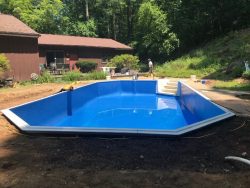The Benefits Of Vinyl Liner Pools
 The Benefits Of Vinyl Liner Pools
The Benefits Of Vinyl Liner Pools
Vinyl liner pools are a popular choice for many homeowners. They are less expensive than concrete or fiberglass and have a wide range of benefits. Pool liners come in a variety of colors, patterns and thicknesses. If you’re not sure what you want, our pool experts can help you choose a liner that will match your home and landscape design.
Durability
When it comes to the longevity of your pool liners, there are a lot of factors at play. The quality of the materials used, the way the liner is built and how often it is maintained all affect the longevity of the pool. One thing that can significantly impact how long a vinyl liner lasts is the water chemistry of your pool. If the chlorine level is high, it will bleach the liner and cause it to fade or even discolor in places. A good water chemistry will also prevent the buildup of dissolved metals, which can stain the vinyl liner. Copper, iron and calcium can combine with the water to form a scale-like coating which will damage your vinyl liner over time. This is why it is important to test for dissolved metals before using any algaecides. This will ensure that you do not damage your vinyl pool. In addition, the right amount of chemicals will maintain your water chemistry and keep your liner looking beautiful for years to come!
Easy Maintenance
Unlike plaster pools, which require repainting every few years, vinyl pool liners can be kept looking new for many years if they are maintained properly. The best way to do this is to keep the water chemistry in check and test it on a regular basis. Maintaining total alkalinity between 80 and 120 parts per million will keep your pool water clear and prevent a scale-like coating that can discolor your liner. Another essential maintenance step is to gently brush your liner on a regular basis. This will help remove dirt, debris, and undissolved chemicals from the liner. A soft-bristle brush or sponge works well for this, but it’s important to use a brush that is compatible with your pool liner. Rough brushing can tear the liner and cause small scratches that can lead to rips over time. It is also a good idea to vacuum your vinyl pool on a regular basis. This will help to remove dirt, debris, and leaves that might be accumulating in your pool over time.
Aesthetics
Vinyl liners are available in an array of colors and patterns to achieve the aesthetic you desire for your pool. Whether you want to go with a natural stone look, a gunite pattern or ceramic tile, there’s something for every homeowner. One of the most important factors in choosing the right vinyl liner for your pool is color. A darker color will absorb sunlight and help to warm the water, while a lighter color will reflect the light more efficiently. Traditionally, blue liners were the most popular choice for pool owners, but today’s vinyl liners come in a variety of aqua color profiles, including tan and sandstone options. Tan liners are particularly attractive to those who want a more lagoon-like look for their pool.
Cost
The initial cost of a vinyl pool can vary depending on the type of materials used to build it. It’s also dependent on whether you choose to install it yourself or hire a professional to do the job for you. One of the major costs associated with a vinyl pool is the liner, which must be replaced every 5 to 9 years. The cost can range from $2,000 to $4,800. Fortunately, there are a few ways to reduce the overall cost of a new vinyl liner. For one, you can always consider installing it yourself if you’re skilled enough to do so. However, be sure to check with the manufacturer’s warranty to make sure doing it yourself will not void the warranty. It could just end up costing you more otherwise.
Categorised in: Vinyl Liner Pools

 The Benefits Of Vinyl Liner Pools
The Benefits Of Vinyl Liner Pools